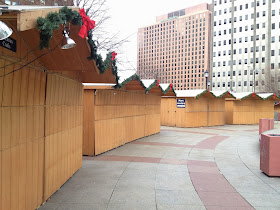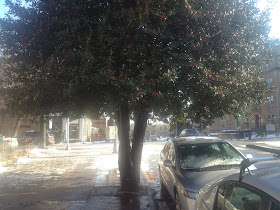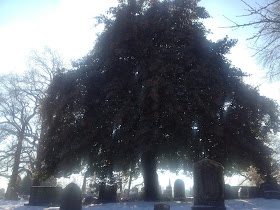It’s coming on
Christmas, they’re cutting down trees…Joni Mitchell
Don’t
you wish every morning could be like Christmas morning?
T’is
the season…waking up in the cozy warmth of a comfy bed, the birds singing in
the bare branches outside the urban cabin window, the weather brisk and frosty…the
beginning of the season of the evergreens, the Long Snow Moon still hovering in
the cold, cloud-bare sky.
Nothing
like jumping out of bed on Christmas morning.
I
know many people use this morning to linger around the house, clad in pajamas
and wool socks, big mugs of hot coffee in their hands, lounging on the couches,
but like most procrastinators, I had a busy morning ahead of me.
I
couldn’t put it off any longer so I headed down to Center City, to Love Park’s
annual Christmas Village, for a little last minute holiday shopping.
Oh
no.
What
happened?
The
place was deserted, all locked up, not a single soul in sight…
…not
even the faintest sound of cheer or music.
Where
was I going to get all my trinkets and knick-knacks?
Where
was I supposed to buy my giant chocolate Santa?
How
was I supposed to decorate the interior landscape of my urban cabin if all the
shops are closed?
Where
did Christmas go?
Mom,
this time it’s not my fault.
Perhaps
I could salvage some part of the holiday.
Around the corner, on the west side of the park, there were still
Christmas trees lined up along the walkway…
…ye
olde favorites like the noble fir and the Alberta spruce but nobody was
scheduled this morning to sell me a tree.
I
guess they overslept, just my luck.
On
the ground at the end of the row, I saw evidence of the feeding frenzy that I
must’ve missed…
…scatterings
of fir branches frosted to the mud.
Unlike
the spruce, the fir grows its green needles in a flat spray along the branches,
much like a comb, bluish-white stripes on the underside…
…sold
here, four dollars a bundle, if anyone was here, that is, to take my money and
save my holiday.
Oh
well. The season is long, the winter has
just begun and it’s like Thoreau once said: there’s
always next year.
He
must’ve said that once in his life.
THE SEASON OF
THE EVERGREENS
Around
this time every year, I am reminded that I missed my true calling in life.
It’s
my one big regret.
If
I could do it all over again, I would’ve pursued a different, more lucrative
career.
I’d
be an agent.
My
dream client? That’s easy.
That’d
be the evergreens.
Around this time every year, more than any other living thing on the planet, the evergreens are exploited and capitalized, merchandized and commercialized up and down every street in every big city and small town all across Turtle Island…
…turning
a profit for every business from Thanksgiving to Christmas…
…and
never seeing a dime for themselves.
That’s
not right.
They
need some sort of representation, some sort of brand standard, some sense of
copyright because, right now, it’s a mess.
The
evergreens are used to sell everything and anything…
…sporting
goods, winter gear, even high fashion…
…and
then, right around the corner, there they are again, hawking everything from
big buckets of popcorn…
…to
seasonal doormats…
…to
local peppermint paddy candy.
It
gets worse.
Without
any representation protecting their brand and their image, the door is wide
open for cheap knockoffs.
Just what in Sam Hill is that?
A
red evergreen?
That's not kosher.
And, of all the evergreens out there, none need my protection more than the holly.
No other tree gets the short shrift like the holly.
This
is not a new problem. Even Donald
Culross Peattie, writing in 1950, addresses the problem: conservation of the Christmas holly from destruction will never be
settled until the public stops buying more than it needs, and the law begins to
police the market.
That
market has never waned from its hunger for holly.
It’s
a sad fate for a truly spectacular tree.
Relegated
and appreciated for only a few weeks out of the year, the holly is one of our
most fascinating and most mystical trees and yet it’s used and over-used,
suckered and hoodwinked to sell the tawdry and the tacky…
…its
current reputation downgraded to a garnish and a festoon, instead of being
regarded as the mighty, fabulous totem it deserves to be.
Exhibit
A? This little piece of chicanery…
…holly
leaves adorning a coffee cup.
Coffee?
That's all wrong.
That’s
not the hot black drink that the holly is normally associated with and, somewhere
high in the Spirit Clouds, the Turtle Clan Chief is having a good laugh
over that one.
I’ll
tell you why.
It’s
time to go holly hunting.
“FULL IN LEAF,
BRIGHT IN BERRY…”
Hollies
aren’t that difficult to find here in the city but you still have to know where
to look.
It’s
rare to see them used as a street tree.
Like
most good street trees, it can survive without the chance of low branches taking up valuable parking spaces…
…but
those tough, spiky leaves are too much of an obstacle on the way from car to
sidewalk.
Not
the kind of the thing you want to bump into after a hard day at the rat-race.
Instead,
most hollies in this city can be found like this…
…as
part of the stone-slabbed, porcelain-potted, bike-racked landscapes commonly called
business parks.
This
type of landscape started popping up here on Turtle Island in the 1950s, conceived
as adult playgrounds for the state-sanctioned daily recesses, the kind of
playground where clothes don’t get dirty, designed with the bagged lunch and
the quick smoke in mind.
These
parks have always been friendly and welcoming to the holly…
…appreciated
for the color it provides even during the coldest, shortest days of winter.
Actually, most city parks will host a holly or two, none more remarkable than
Rittenhouse Park.
Every
corner of Rittenhouse Park is guarded by a pair of hollies.
My
favorite pair?
The
two pyramids that tower over the southwestern corner…
…the
tall twins standing watch.
Hollies
are also commonly found right next to the facades of buildings…
…a
constant insulation against the blazing sun in the summer and a constant
barricade against the winds of winter but it’s best loved for its music…
…a
popular roost for songbirds all year long.
But, by far, the most common place to find a holly here in the city has to be the church.
Here,
it’s actually possible to stand under the holly to catch a glimpse of the sky
through its tight, tense foliage.
It’s
also a good place to see one of the holly’s most common neighbors: the English
ivy, the Hedera helix…
…those
starry-shaped vines usually found creeping up the holly trunk.
Now
my favorite holly in the entire city?
It’s
not that far from my urban cabin, just a few blocks down on the other side of
the trolley junction, dignifying the grounds of the Woodlands Cemetery...
…hunted
down and caught by yours truly on one recent snowy day.
THE ILEX
AQUIFOLIUM
Now
that was good place to watch the snow melt.
Underneath
the tree, the ground was already thawed and muddy, decked with fallen boughs
of holly.
We
think of the holly as a Christmas tree, not only the source of the holiday’s
color scheme but also as a perfect metaphor for Jesus’s crucifixion…
…the
crown of thorns dotted with those blood-red berries.
But
the holly was used as a holiday decoration far longer than the first Christmas,
back when the holiday was called Saturnalia.
Holly
was the sacred plant of the Roman god Saturn, known as the Eater of Time, which
is why his holiday appears at the end of the calendar year.
And,
according to the Druid epic called The Battle
of the Trees, at around this time of year, the Holly King would fight for
supremacy of the forest, always coming out triumphant against the Oak King…
…standing
victorious as the only tree left in the forest still green and bearing fruit.
This
is why the English Christmas carol called The
Holly and the Ivy has the lyric: of
all the trees in the wood, the holly bears the crown.
That’s
all good and true but, for me, it’s all about those leaves.
Those
leaves tell the best part of the holly story.
They’re
not the kind of leaf commonly found in the eastern hardwood forests, instantly
recognizable as a stranger to these parts.
They’re
too thick and too glossy to fit in with the rest of the canopy but that’s the
whole point.
That’s
the holly.
For
this tree is a relic, a reminder of the distant past, a souvenir from the prehistoric, dank
forests of the super-continent Gondwana.
There
are only a few Gondwana sites left in the world today, commonly called cloud forests, located in the high
altitudes of the rainforest…
…the
land of the perpetual fog, over 300 inches of rain every year in the form of
dripping, clingy mist…
…home
to the moss, the ivy, the orchid and the gorilla…
…that’s
where the holly comes from.
It’s
one of the few trees to escape that kind of forest and find a place here
amongst the pines, the oaks, the sycamores and the maples.
And
that’s why those uncommon leaves make so much sense.
It
needs to be thick and glossy to keep all that water from penetrating and drowning their
cell walls…
…little
chance for fungus, mold or rot.
And
it needs those sharp and tapered barbs most of all, so all that water can just
slide on off…
…that’s
why they’re called drip tips.
Birds can go crazy for those berries all they
want but, for us, we go nuts for those leaves.
In
South America, the holly leaves are dried and crushed to powder, sold in the
market nowadays under the name Yerba Mate.
Up
here, the leaves of the Yaupon holly were harvested for their high caffeine
content, dried and roasted, then ground and brewed into something that the
Native Americans called the black drink.
After
a couple days of fasting, the black drink was passed around the ceremonial
circle, everyone receiving a small shot served in a hollowed-out snail shell.
Did
you hear that, Macy’s? Not a coffee cup.
A
snail shell.
That’s
how you drink the holly.
A
few moments after drinking, according to the early pioneer journals, that’s
when the ritual vomiting began and, a few moments later, that’s when the
visions started.
A
few moments after that, it’s spring again.
I
admit. Black drink, snail shells, ritual
vomiting, communal vision quests?
It’s
not everybody’s cup of tea.
It’s
not exactly what we modern Americans have in mind when we say eat, drink and be merry but, like we also
say on occasion, to everything there is a season.


















































Another great post Jon Spruce, Agent of the Evergreens.
ReplyDeleteWhy, thank you very much, Anonymous. Have a great new year.
ReplyDelete